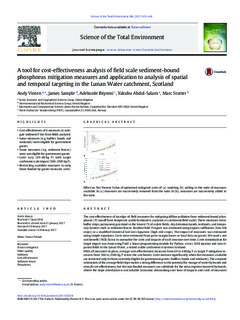A tool for cost-effectiveness analysis of field scale sediment-bound phosphorus mitigation measures and application to analysis of spatial and temporal targeting in the Lunan Water catchment, Scotland
Journal article, Peer reviewed
Published version
Permanent lenke
http://hdl.handle.net/11250/2490889Utgivelsesdato
2017Metadata
Vis full innførselSamlinger
- Publikasjoner fra Cristin - NIVA [2149]
- Scientific publications [1172]
Originalversjon
Science of the Total Environment. 2017, 586, 631-641 10.1016/j.scitotenv.2017.02.034Sammendrag
The cost-effectiveness of six edge-of-field measures for mitigating diffuse pollution fromsediment bound phos- phorus (P) runoff from temperate arable farmland is analysed at catchment/field scales. These measureswere: buffer strips, permanent grassland in the lowest 7% of arable fields, dry detention bunds, wetlands, and tempo- rary barriers such as sediment fences. Baseline field P export was estimated using export coefficients (low risk crops) or a modified Universal Soil Loss Equation (high risk crops). The impact of measures was estimated using simple equations. Costs were estimated from gross margin losses or local data on grants. We used a net cost:benefit (NCB) factor to normalise the costs and impacts of each measure over time. Costs minimisation for target impact was done using PuLP, a linear programming module for Python, across 1634 riparian and non-ri- parian fields in the Lunan Water, a mixed arable catchment in Eastern Scotland

